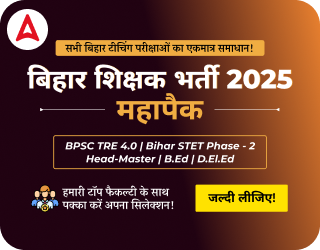Table of Contents
The Uttar Pradesh Secondary Education Services Selection Board (UPSESSB) has officially released the UP PGT Physics Syllabus on its website. Candidates preparing for the exam should carefully review the syllabus to gain a clear understanding of the exam pattern, marks distribution, marking scheme, and key topics covered. For a detailed breakdown and expert guidance, refer to the following article, which provides a comprehensive overview of the UP PGT Physics Syllabus 2025.
UP PGT Physics Syllabus
UPSESSB has announced the UP TGT PGT Exam Date 2025 for 4,163 vacancies, making it essential for candidates to thoroughly review the UP TGT PGT Syllabus 2025 and plan their preparation accordingly. The UP PGT Physics Syllabus plays a crucial role in guiding candidates through key topics, ensuring a strategic approach to the exam.
The syllabus covers fundamental and advanced concepts, including Mechanics, Thermodynamics, Electromagnetism, Optics, Modern Physics, and Electronics. The exam consists of 125 multiple-choice questions (MCQs), carrying a total of 425 marks, with no negative marking. A clear understanding of the syllabus helps candidates focus their studies, manage time effectively, and improve accuracy- key factors for securing a teaching position in Uttar Pradesh government schools.
UP PGT Physics Exam Pattern 2025
The UP Exam Pattern 2025 for PGT Physics includes a single written examination with 125 multiple-choice questions (MCQs), carrying a total of 425 marks. Each question is worth 3.4 marks, and candidates will have 2 hours to complete the exam. Notably, there is no negative marking for incorrect answers. This exam pattern is structured to assess candidates’ subject knowledge, teaching aptitude, and reasoning skills. To enhance their chances of success, aspirants must prepare thoroughly, covering all relevant topics strategically.
| UP PGT Physics Exam Pattern 2025 | |
| No. of Questions | 125 Questions |
| Time Duration | 2 hours |
| Marks | 425 |
| Negative Marking | No |
| Each Question | 3.4 marks |
| Type of Questions | MCQ |
UP PGT Physics Marks Distribution 2025
The UP PGT Physics Marks Distribution 2025 is structured into three key components, totaling 500 marks. The written exam carries the highest weightage at 425 marks (85%), focusing on subject knowledge and teaching aptitude. The interview accounts for 50 marks (10%), assessing candidates’ communication skills, subject expertise, and overall suitability for the role. Additionally, special qualifications such as MEd, PhD, or NET contribute 25 marks (5%). This well-defined marking scheme ensures a comprehensive and fair evaluation of candidates based on their academic credentials, teaching abilities, and additional qualifications.
| UP PGT Physics Marks Weightage 2025 | |||||
| S.No. | Exam | For PGT Post | For TGT Post | ||
| Marks | Percentage | Marks | Percentage | ||
| 1 | Written Exam | 425 | 85 | 500 | 100 |
| 2 | Interview | 50 | 10 | ||
| 3 | Special Qualification | 25 | 5 | – | – |
| Total | 500 | 100 | 500 | 100 | |
UP PGT Physics Syllabus Detailed
The UP PGT Physics Syllabus encompasses a broad range of topics, ensuring a comprehensive evaluation of candidates’ proficiency in key areas of physics. It includes Classical Mechanics, Thermal Physics, Electromagnetism, Optics, Modern Physics, and Electronics.
Key topics covered within these domains include kinematics, Newton’s laws, rotational motion, gravitation, thermodynamics, kinetic theory of gases, electrostatics, current electricity, and electromagnetic induction. Additionally, the syllabus features wave optics, interference, diffraction, polarization, quantum mechanics, atomic structure, nuclear physics, and semiconductor devices. Designed to assess both conceptual clarity and problem-solving skills, the syllabus emphasizes a strong understanding of fundamental principles and their practical applications in physics.
| UP PGT Physics Syllabus Detailed | |
| Unit | Description |
| Mechanics |
|
| Thermal Physics |
|
| Optics |
|
| Waves & Oscillations |
|
| Electromagnetism |
|
| Modern Physics |
|
UP PGT Physics Syllabus 2025 PDF
Candidates can refer to the table below to download the UP PGT Physics Syllabus PDF. Going through the syllabus before beginning their preparation will help them understand the important topics and structure their study plan efficiently. Regularly revisiting the syllabus throughout their preparation will ensure they stay focused and fine-tune their strategy for better performance.
| UP PGT Physics Syllabus PDF | |
| UP PGT Physics Syllabus 2025 | Download PDF Now |
| UP TGT PGT 2025 Important Links | |
| UP TGT PGT Notification 2025 | UP TGT PGT Syllabus 2025 |
| UP TGT PGT Previous Year Question Papers | UP TGT PGT Eligibility Criteria 2025 |




 KARTET Syllabus 2025, Download Paper 1 a...
KARTET Syllabus 2025, Download Paper 1 a...
 Assam SLET Syllabus 2026 PDF Download Su...
Assam SLET Syllabus 2026 PDF Download Su...
 Rajasthan BSTC Syllabus 2026, Download P...
Rajasthan BSTC Syllabus 2026, Download P...












